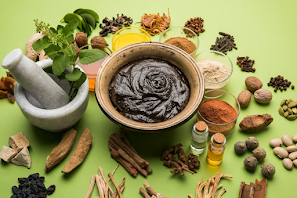The government of India has created ministry for AYUSH for active promotion of ancient therapies such as Ayurveda, Yoga & Naturopathy, Unani, Siddha, Sowa Rigpa and Homeopathy. Government has also set up All India Institute of Ayurveda in Delhi and Goa to promote research in Ayurveda and offer PG & PhD programs while providing Ayurvedic treatment. Encouraged by these government initiatives, many companies like Patanjali have launched many Ayurvedic products and advertise them in newspapers and other media claiming treatments for various diseases in violation of "Drugs and Magic Remedies (Objectionable Advertisements) Act, 1954."
Many of the advertised medicines contain common herbs and claim to permanently cure diseases like BP, Diabetes, heart ailments, asthma, thyroid, infertility and even cancers. With my Pharmacy background, I found these claims to be outlandish and unscientific. However before coming to conclusion, I decided to read one of the main books "Susruta Samhita" on which Ayurveda is based.
The Susruta Samhita captures the symptoms of many diseases such as diabetes, jaundice, epilepsy, skin diseases (including leprosy), tumors, ulcers, gynecologic problems etc. All these are attributed to imbalance in Vata, Pitta & Kapha. Some are also attributed to immoral behaviors' and sins. Many of the diseases are mentioned as incurable. Some diseases, mainly attributed to sins are also mentioned to be transferable to next life unless the patient makes necessary amends and performs appropriate penance. The remedies suggested for various diseases include different plant extracts, some materials of mineral origin including salts of lead, mercury and arsenic (which are actually poisons), common ingredients such as milk, ghee, cow urine and dung, There is no information about what these remedies contain, how they work or how the dose is decided. Apart from these remedies book also describes precautions to be taken in case of some diseases including food restrictions without providing any scientific rationale. The book also describes various conditions such as menstruation, pregnancy etc and precautions to be followed during those. Many of these are unscientific. Book also includes the description of various body parts. The number of bones, muscles, arteries and veins mentioned in the book closely matches the actual numbers. There is also description of many surgical procedures, tools to be used and precautions to be taken. These indicate that the medical practitioners during those days had acquired fairly good knowledge about human anatomy which could be observed through naked eyes and dissections. While the knowledge of anatomy was fairly developed, that of physiology and nervous system appeared to be non-existent. Obviously in absence of diagnostic tools such as microscopes, blood analyzers etc, one can not develop understanding of how the various parts of the body function.
In the nutshell, Ayurveda is based on Tridosha theory, which presumes that three doshas, namely Vata, Pitta, and Kapha, are the three pillars of life. Each dosha is presumed to draw its energy from a combination of five elements, i.e., space, air, water, fire, and earth. While each dosha has all five elements, two elements are supposed to be predominant in each. For example, Pitta is predominantly a combination of fire and water. These doshas are a form of "energy" that pervade the body while being concentrated in specific parts of the human body influencing certain aspects of functioning. Ayurveda characterizes each person's body type into one of these three categories of doshas. For example, pitta supposedly governs digestion, absorption, assimilation, nutrition, metabolism, body temperature. As long as pitta is in balance, It supposedly promotes understanding and intelligence. If it is out of balance, pitta supposedly arouses anger hatred, jealousy, and inflammatory disorders. The three doshas work under the impact of the environmental factors and consequently undergo fluctuations according to change in time (diurnal, nocturnal and seasonal), age and with relation to food. An imbalance of doshas is considered to be one of the main reasons for diseases in the human body, apart from external factors.
This concept of balance in Ayurveda has some similarities to the humoral theory of medicine that underlies Greek medicine, which also forms the basis of Unani system of medicine. Those who have studied anatomy, physiology and pharmacology will realize how flawed this theory is. Greece & other Western nations have moved on to modern medicines with the advent of scientific knowledge, including theories like cell theory and germ theory and better understanding of anatomy and physiology. However, Indian government flooded with uneducated people continue to promote these ancient unscientific medicines and have even set up ministry for it.
I am not saying that all Ayurvedic medicines are useless. Some may have an effect against specific ailments. We should realize that these medicines (mostly from herbal and mineral origin) have been arrived at by trial and error by old practitioners and some are now known to be poisonous. There is no scientific rationale or knowledge about their chemical composition, strength, dose, mode of action, side effects, pharmacodynamics, pharmacokinetics, etc. Similarly the safety and efficacy of these medicines have not been proven by scientific clinical studies. There are also no scientifically sound standards and validated test methods to evaluate the quality of these medicines. Under these circumstances allowing use of these medicines without generating the missing scientific data is dangerous. Ayurvedic institutions need to work on generating the missing data so that some of the medicines which meet the required scrutiny can be brought into modern medicines. The basic philosophy that imbalance of Vata, Pitta & Kapha is responsible for all the ailments is however totally flawed and need to scrapped in light of new scientific knowledge about human body and pathology of diseases.
Ganadhish Kamat




Excellent Sir
ReplyDeleteFully agreed sir... it's commendable as you gone through the ancient shastras to respond against the misunderstood Ayurveda.
ReplyDeleteThis misunderstanding about Ayurveda specially arised high during and after pendamic.
Insightful
ReplyDelete